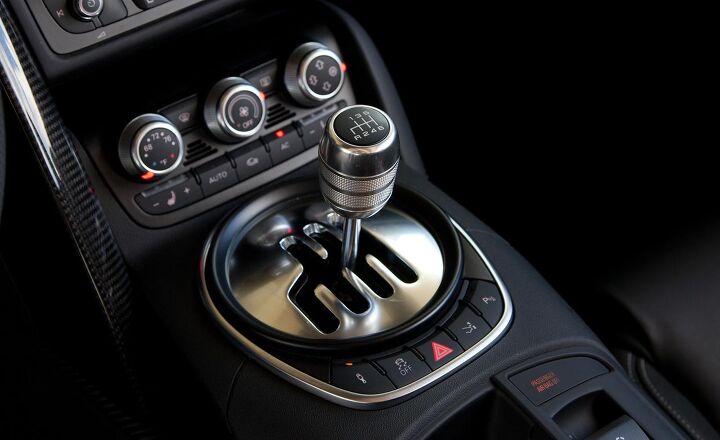Editorial: You're The Reason Auto Makers Don't Offer Manual Transmissions
One of the essential questions that many automotive writers fail to examine is “what is the nature of an automaker”? All too often, they lose sight of the fact that OEMs are in the business of selling cars, not manufacturing widgets for people who like cars.
This kind of mindset is what leads to the exchange outlined in Automobile Magazine, where one writer discusses the lack of a manual transmission in the 2016 Audi R8.
“You have to look at lap times,” he said at the 2015 Geneva auto show, adding that the take rate for manual transmission-equipped Audi R8s, at least in Europe, was almost nil. When pressed on the issue, Hollerweger remained firm. There is simply is no way for a stick-shift to match the performance of the R8’s dual-clutch transmission and few buyers wanted one, so Hollerweger believes there’s no point in offering a manual on the new car.
Of course, we’d beg to differ and we were a bit taken aback by his assertion that a manual-equipped car is not the more engaging experience for the driver.”
Emphasis added by yours truly. But that assertion alone highlights what is either a total lack of understanding regarding the auto industry, or willful blindness. The R8 is a halo car for Audi, and you can bet that they spent lots of time and money doing market research, analyzing sales data and talking to current and prospective customers about what they want in a car.
A manual is not something they want. It is what you want, and what I want, but the people signing the $200,000 checks have little to no interest in the purity and tactile supremacy of a clutch pedal and a gated manual shifter. Therefore, Audi has decided not to offer one, sparing them tens of millions in costs, regulatory headaches, fewer combinations that complicate the assembly process and three-pedal versions that sit on dealer lots collecting dust. It’s not a difficult decision to understand, but our ego is designed to protect us from thinking that we are somehow less important to Audi than the (very wealthy) customers who are supporting the brand by actually purchasing their products.
And yet, this writer begs to differ. On what grounds? Because it’s cool? Because it’s a shame to see the manual die out? Because you think they should. Sorry, but in the world of ROI and P&L statements (which make a car company stay in business), those reasons are less than worthless. If you don’t live and die by that line of thinking, then you’re Lotus, barely existing despite doing everything right in the eyes of the enthusiast.
The entitlement that comes with thinking that a particular car or variant thereof should simply exist for the sake of it is something I can’t wrap my head around. Whether a car that you’ll never ever buy has two pedals or three, a stick shift or paddles has literally zero impact on your daily life. There’s a good chance that you will never even see a 2016 Audi R8 on the road, depending on what part of the country you live in. And yet every time a new car is released without a manual, we have people rending their garments over this matter.
There is literally only one way to ensure the continued existence of the manual transmission. You have to buy new cars with manual transmissions. Car companies, like people, respond to incentives. Increased sales of manual transmissions in new vehicles (not used) is an incentive for them to offer more. Whining about their demise is not. We are not entitled to anything in this world, let alone an unpopular, costly (for the car maker) option that by all rights should have disappeared long ago.
So why not reward the people who are still doing God’s work and offering you three pedals and a real stick shift (and I really do mean that, because all of the product planners I know do their best to make the case to management for offering a manual, even if it means sticking their neck out)? Bark did. Jack did. I did. Do your part. Vote with your wallet. Here’s a list of cars that offer one, and there is still a manual option to fit every conceivable need. If everyone that complained about a lack of manuals actually bought a new car with a manual, we’d be like Europe. If you have no intention of buying a new car with a manual transmission, then you have lost your right to complain.
More by Derek Kreindler
Latest Car Reviews
Read moreLatest Product Reviews
Read moreRecent Comments
- SCE to AUX How well does the rear camera work in the rain and snow?
- MaintenanceCosts The Truth About Isuzu Troopers!
- Jalop1991 MC's silence in this thread is absolutely deafening.
- MaintenanceCosts Spent some time last summer with a slightly older Expedition Max with about 100k miles on the clock, borrowed from a friend for a Colorado mountain trip.It worked pretty well on the trip we used it for. The EcoBoost in this fairly high state of tune has a freight train feeling and just keeps pulling even way up at 12k ft. There is unending space inside; at one point we had six adults, two children, and several people's worth of luggage inside, with room left over. It was comfortable to ride in and well-equipped.But it is huge. My wife refused to drive it because she couldn't get comfortable with the size. I used to be a professional bus driver and it reminded me quite a bit of driving a bus. It was longer than quite a few parking spots. Fortunately, the trip didn't involve anything more urban than Denver suburbs, so the size didn't cause any real problems, but it reminded me that I don't really want such a behemoth as a daily driver.
- Jalop1991 It seems to me this opens GM to start substituting parts and making changes without telling anyone, AND without breaking any agreements with Allison. Or does no one remember Ignitionswitchgate?At the core of the problem is a part in the vehicle's ignition switch that is 1.6 millimeters less "springy" than it should be. Because this part produces weaker tension, ignition keys in the cars may turn off the engine if shaken just the right way...2001: GM detects the defect during pre-production testing of the Saturn Ion.2003: A service technician closes an inquiry into a stalling Saturn Ion after changing the key ring and noticing the problem was fixed.2004: GM recognizes the defect again as the Chevrolet Cobalt replaces the Cavalier.fast forward through the denials, driver deaths, and government bailouts2012: GM identifies four crashes and four corresponding fatalities (all involving 2004 Saturn Ions) along with six other injuries from four other crashes attributable to the defect.Sept. 4, 2012: GM reports August 2012 sales were up 10 percent from the previous year, with Chevrolet passenger car sales up 25 percent.June 2013: A deposition by a Cobalt program engineer says the company made a "business decision not to fix this problem," raising questions of whether GM consciously decided to launch the Cobalt despite knowing of a defect.Dec. 9, 2013: Treasury Secretary Jacob Lew announces the government had sold the last of what was previously a 60 percent stake in GM, ending the bailout. The bailout had cost taxpayers $10 billion on a $49.5 billion investment.End of 2013: GM determines that the faulty ignition switch is to blame for at least 31 crashes and 13 deaths.It took over 10 years for GM to admit fault.And all because an engineer decided to trim a pin by tenths of a millimeter, without testing and without getting anyone else's approval.Fast forward to 2026, and the Allison name is no longer affiliated with the transmissions. You do the math.


































Comments
Join the conversation
I read this story every couple of months. It's just so perfect. Also LOLing at the purported unreliability of automatics. A modern automatic is pretty damn robust, and will last longer than, while costing not much more to replace than a clutch. Rebuilt autos are pretty cheap and autos in general are pretty durable.
Manuals suck, there I said it. On one hand, you have a system that does every shift perfectly, and on the other hand you have "pro-drivers" who claim they do every shift perfectly with their manual. It's like photographers who miss the view-finder (which has been replaced with the superior LCD, which actually shows what the camera's sensor sees, not what your eyes see)